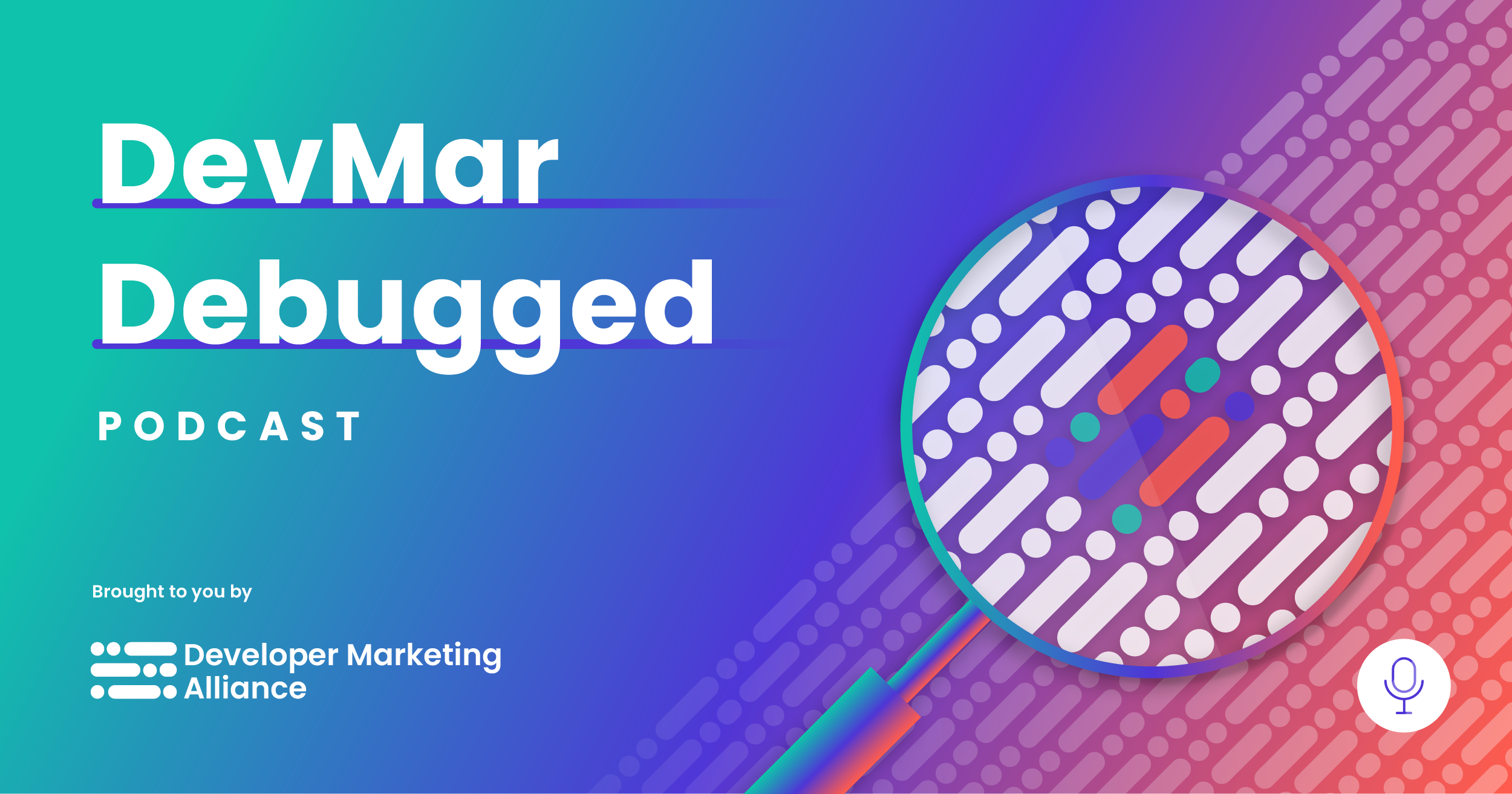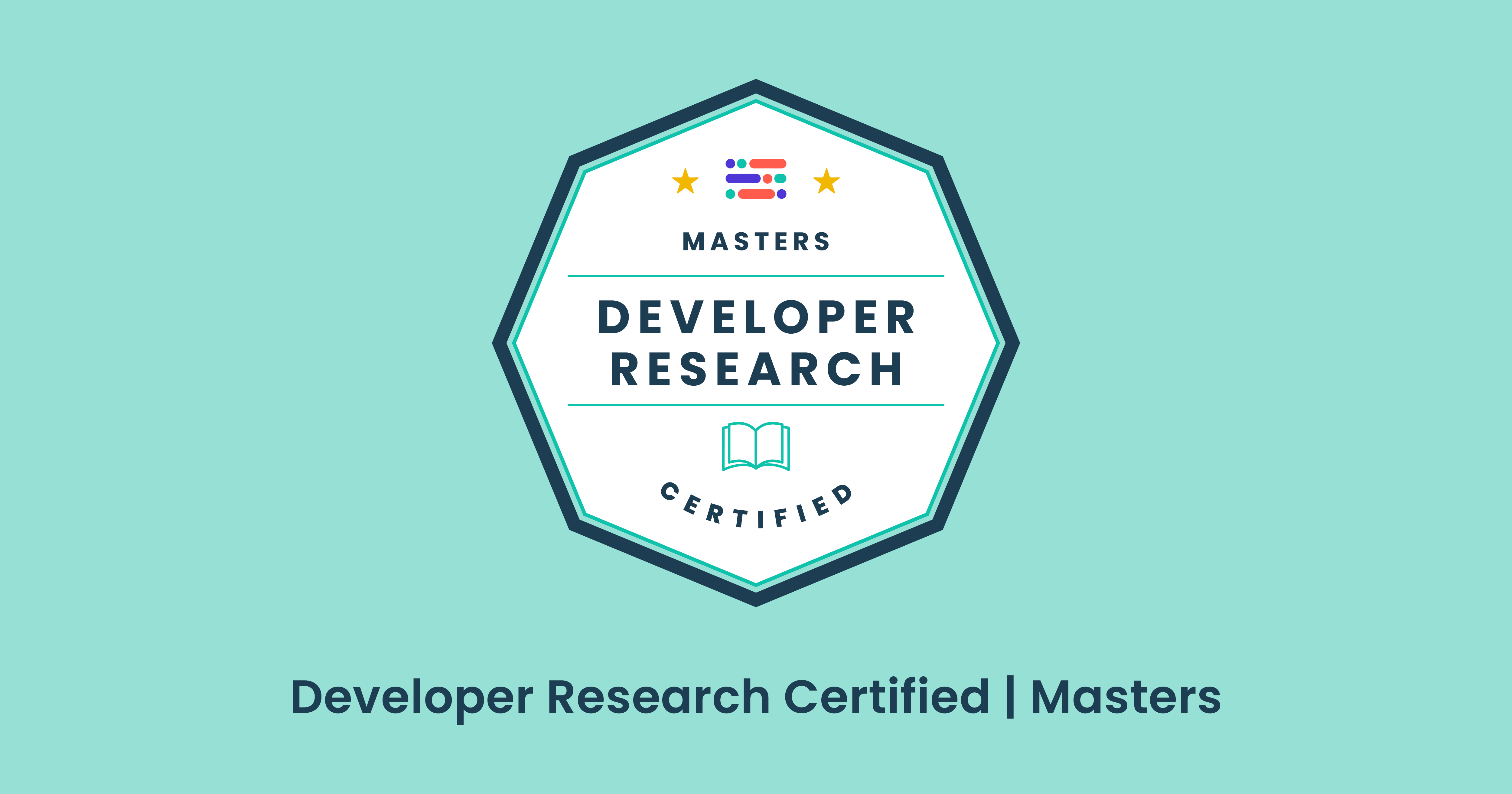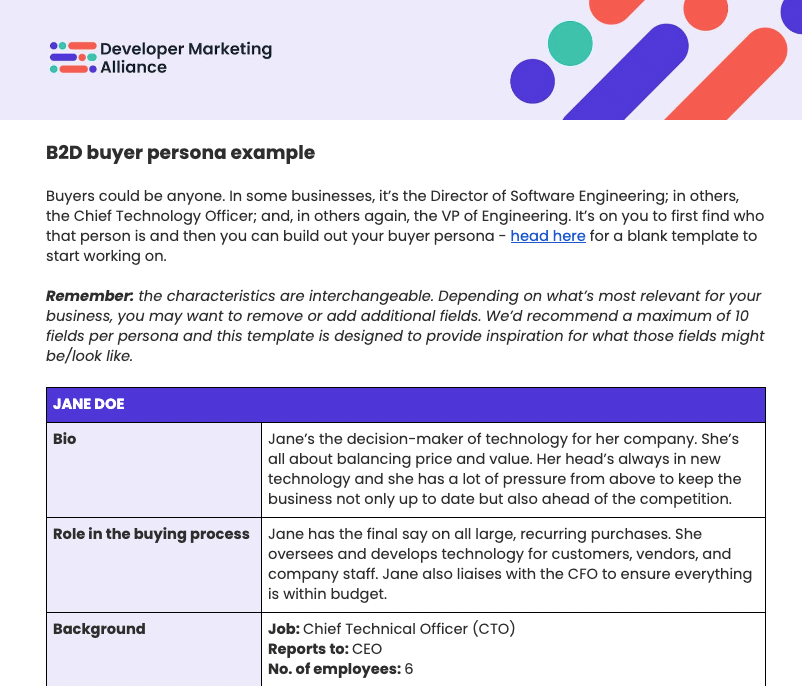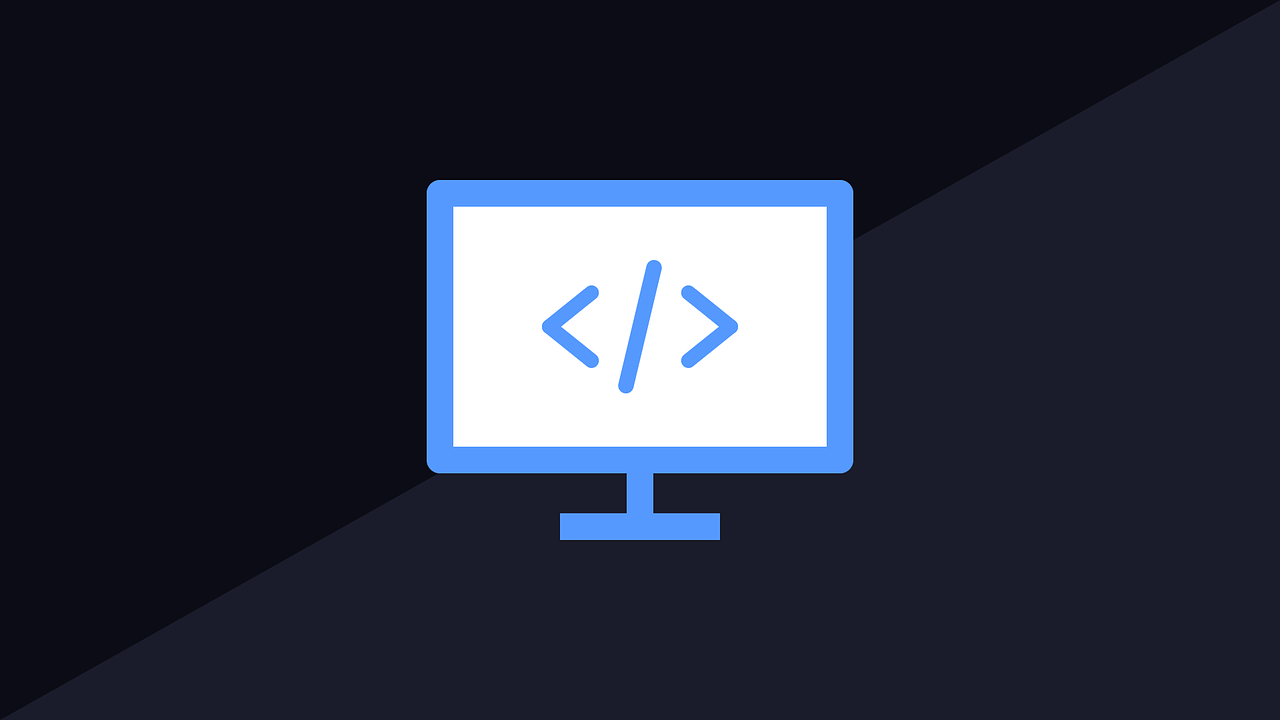Do you know your developer audience’s pain points? Are you aware of what makes them tick? Developer personas help you personalize your segment of the market and gain a deeper understanding of developers’ needs, traits, behaviors, experiences, goals, etc.
Developer personas also help you to create realistic depictions of your audience, as they’re backed by both qualitative and quantitative research.
They’re essential for your developer relations and developer marketing plans, and allow you to more easily recognize how different product users have different expectations.
What we’re talking about:
- What are personas?
- What is a developer persona?
- Why should you create a negative persona?
- Buyer persona vs. user persona?
- Are developer personas different from buyer personas?
- Why is creating developer personas so important in the first place?
- Who should be involved in creating your buyer personas?
- How many developer personas should you create?
- What are developer personas best practices?
- What are the 8 steps to create a developer persona?
- Developer personas at Developer Marketing Alliance
Bookmark the page or download the free guide in PDF format so you can always refer back to the many tips, strategies, and insights within it!
You can also download the How Developers Think: A Persona Playbook, packed full of expert content and tips to help you!

What are personas?
Simply put, personas are semi-fictitious (and archetypical) representations of a larger group of people – in this case, your product’s users or buyers. They can include a wide range of information, ranging from job titles and key responsibilities to goals and technical expertise.
Personas help you keep people at the heart of every decision you make and every marketing strategy you choose; this, in turn, will help you to create a better product.
In short, a persona embodies your ideal customer, so think about who’s using or buying your product.
What is a developer persona?
Developer personas are also semi-fictitious depictions of real-life product users and/or buyers – in this case, developers and other technical-minded people. They help you to grasp your specific audience’s experiences, behaviors, goals, and so much more.
With these personas, you can more easily provide a good customer journey and experience, which, in return, should improve churn rate and retention. Equally, developer personas can guide your developer marketing strategies and tactics, from the ideation phase to metrics.
Why should you create a negative persona?
Negative personas are the representation of a group of people who aren't your ideal audience. In short, they embody the needs, values, pain points, motivations, behaviors, etc., of people who are so different from your customers that you shouldn’t bother with them.
But, we hear you ask, if you shouldn’t bother with them, why should you create a negative persona in the first place?
Benefits of using negative developer personas in your marketing include:
- They can tell you who’s a bad fit for your product (saving you time, money, and effort),
- They help you optimize your ideal developer personas, and
- Allow you to tweak your messaging to hit the right audience.

Buyer persona vs. user persona?
There is a difference between buyer and user personas because they’re not always the same audience. For example, if you have a CTO buyer persona, you must consider they might buy a product for the development team, but it’s the devs who will use it. However, maybe a developer will both buy and use the product – in this case, the buyer and user are the same.
Still, it’s important to consider that user and buyer personas have different goals. User personas should help you understand how the end user of your product behaves, their pain points, etc. Buyer personas are there to help you understand how people make purchasing decisions.
This means that, even though the buyer can also be the user, they can exhibit different behaviors and motivations when acting as one or the other.
Are developer personas different from buyer personas?
It depends! If the developer is buying the product, then they can be part of your buyer personas. If they’re just using it, then no, they’re your user personas.
Why is creating developer personas so important in the first place?
As mentioned above, there are many benefits of implementing well-defined developer personas in your org. Here are just a few of them.
Helps everyone understand your audience
Having a set of developer personas that everyone in your organization can access is important. This includes everyone from the C-suite to managers in different departments like marketing and sales. It ensures that your company’s ideal customer is clear to everyone.

Gives you deep knowledge of needs and pain points
Developer personas help you to gain a deep knowledge of your customers; including their goals, their motivations, their behaviors, etc. In the case of buyer personas, they can also help you understand your audience’s purchasing patterns.
By creating developer personas, you can more easily create tailored messaging, product features, and content that meets your audience’s specific requirements.
Improves your targeting for better engagement
As mentioned, you can create products and content that are super relevant to your segment of the market. Your marketing messaging will be tailored and you can more easily deliver this message to the right people at the right time.
What’s more, developer personas provide a guide for you to perform market research and SEO research – it also allows you to create better ads that have a higher chance of converting people.
Allows you to stand out from the crowd
Because developer personas allow you to create better content, it stands to reason that you can set yourself apart from your competitors with content that resonates more closely with your audience and solves their issues.
When you have a deep understanding of your audience, you can better reach out to developers and offer them answers to questions they don’t know they have.
Boost your product strategy
With a detailed, thorough, and deep analysis of your audience, your product strategy is better informed. You get insights on who the product is for, the features you should prioritize, the pain points you’re addressing (or not addressing), and so on.
Who should be involved in creating your buyer personas?
It will vary, but try to think of everyone who’ll have knowledge of your target audience. Will your executive leadership? Your sales team? What about marketing?
By gathering knowledge from different people or teams, you can create better developer personas. These personas will reflect the values, goals, motivations, and behaviors of your product's users or buyers.

How many developer personas should you create?
As many as you need! Who’s your target audience? Who’s going to buy your product? If you're targeting software developers in the early stages of their career, then your personas should reflect that.
Likewise, if your target audience is ‘senior leadership’ or even C-suite, take a moment to consider (and visualize) who your customers are.
What are developer personas best practices?
What are some of the best practices to help you build detailed personas?
Research your developer personas
To develop psychographic segments, the marketer must understand consumers!
When creating your personas, you’re not pulling data out of thin air – on the contrary, accurate developer personas that actually represent your customers and are actionable are the result of research.
The personas are the goal, not the guide; this means that you should use research (for example, surveys) to inform your personas and not the other way around.
In short, keep this mantra in mind: no data = no persona.

Don’t muddle your developer personas with useless information
Personas can be a lot of fun to create but it’s equally important not to get too carried away… you may find persona templates out there that come with a million and one categories, including hobbies and even personality type.
However, none of this data is useful to you, your team or your org. In fact, they can make the user or buyer persona cluttered and difficult to read. Keep only the truly vital information (goals, values, issues…) and avoid extraneous things that don’t clarify who your target audience is or what they need.
Understand how to best use your personas
So, you’ve created your developer personas – now what? How do you know when to use them? And how? It all starts by understanding why you need them in the first place. If you have a clear goal from the beginning when creating your personas, you’ll also know when you deploy them.
Everyone should be using your developer personas, as it’s not just a marketing tactic. After all, they give you key information about your customer, including how they use your product and whether they’re ready to purchase.
Dev teams can also benefit from personas. If you’re building a product, it’s important everyone knows who it’s for.
It’s easier to empathize with Mary, DevOps engineer or game dev who lives in New York, than with a vague user with undefined requirements. Therefore, they may find it easier to identify what the customer wants or needs.
Focus on just one thing
You may find developer persona templates with a long list of goals; while that’s not completely wrong, as personas can have several issues they want to solve, it might be best to focus on just one main problem. This can help you to stay on track and find it easier to make decisions.
Update your developer personas regularly
Personas shouldn’t be static! Your company, your product, your features, your customers, the market – everything changes, so your developer personas should change in that case as well. Ideally, they should be adaptable to handle agile environments, but they also need to be revised regularly to ensure they’re still relevant.
Reconsider demographics
One thing some people disagree about is demographics. While some say it’s an essential element to creating developer personas and should be included in the process, others believe that it’s an irrelevant factor and experience and job role are much more important (and accurate) ways of representing a group of people.
Use a template
The good news is that you don’t have to reinvent the wheel. There are plenty of templates (including in the Developer Marketing Alliance membership) you can use to create your developer personas.

What are the 8 steps to create a developer persona?
So, how do you actually create developer personas? What does the process involve? Here are some steps to consider when building your personas. These steps are not fixed rules, but they can help you create strong personas.
1. Do research
The first thing you must do is conduct research, whether it’s qualitative or quantitative – or both. Understand your market and your competitors, find out whether there’s a need for your product and who’d want to buy/use it, etc. It doesn’t matter if you’re a small start-up or an enterprise, research is an unskippable step.
2. Ask yourself what problem you’re solving
Your product should be meeting a requirement, fixing a problem, solving a need, etc. This should be clear from the get-go so you can make it clear to your developer audience as well.
No one enjoys buying software; they do it out of necessity. When creating your developer persona, focus on your product's main selling points. Make sure these points are clear in your documentation.
3. Analyze the data and segment your audience
Next, you want to analyze the information you got and find patterns, so that you can then segment your audience and target the right group of people.
Breaking your customer base into smaller segments can be tough. It’s important to know the different types of segmentation.
- Geographic
- Demographic
- Psychographic
- Behavioral
Why should you segment your market? By doing so, you can more easily create messaging tailored to the right group of people and stand out from the crowd, as well as choose your advertising channels more efficiently.
Geographic segmentation does what it says on the tin. You can split your audience by physical location and urban/rural areas, for example.
Demographics are all about age, gender, and education level, while psychographic segmentation focuses on values, motivations, goals, priorities, likes and dislikes, and other similar factors.
Finally, behavioral segmentation refers to buying patterns, the way people interact with your company, etc.
4. Define the persona’s goals
Just like your real-life customers, your personas should have goals as well. Your product should allow them to meet these goals, so ensure they align with yours. By having goals, you can more easily keep your audience’s needs in mind and create strategies and messaging that meets them.

5. Define motivations and pain points
Another important step is to fill out your personas’ docs with things like values, motivations and pain points. This means understanding what frustrates your target audience, what makes them tick, the problems they have, etc. This helps you to provide a better developer experience.
You can find all this out by performing in-depth research and by following our next step, talking to developers.
6. Talk to your developers
If you’re not sure about something or are worried your developer personas aren't detailed enough, then talk to your audience and have them fill in those gaps. You don’t have to just rely on your initial research – if needed, you can approach devs and request their input or opinion on your personas.
This is why it’s important to build relationships with developers, especially in a developer community. They can give you feedback and help you improve your product, features, services, and more.
7. Share (and use) your developer personas
Good developer personas take effort to build, so don’t shelve them once they’re done. Share your findings with your team.
Ask for feedback and make improvements. Apply these changes where they matter most. For example, use them during onboarding or when developers are unsure about buying your product.
8. Review your personas regularly
Things are always changing, as we mention above, so make sure you’re reviewing and tweaking your developer personas often to account for new insights.
Developer personas at Developer Marketing Alliance
To summarize, whether you want to create a game dev or a software developer persona, there are certain elements that should be included, such as work responsibilities, main challenges, motivations, and goals. This will help you better understand the group of people the persona is representing.
We offer templates and frameworks to Developer Marketing Alliance members, including on developer personas, which are designed to make your life 1,000x easier – check out our membership plans to see what you get when you sign up.
Together with Instruqt, we're on a mission to discover how orgs drive developer adoption, the challenges teams face, and how long it takes for devs to adopt a product.
Take our survey and help shape developer adoption.






